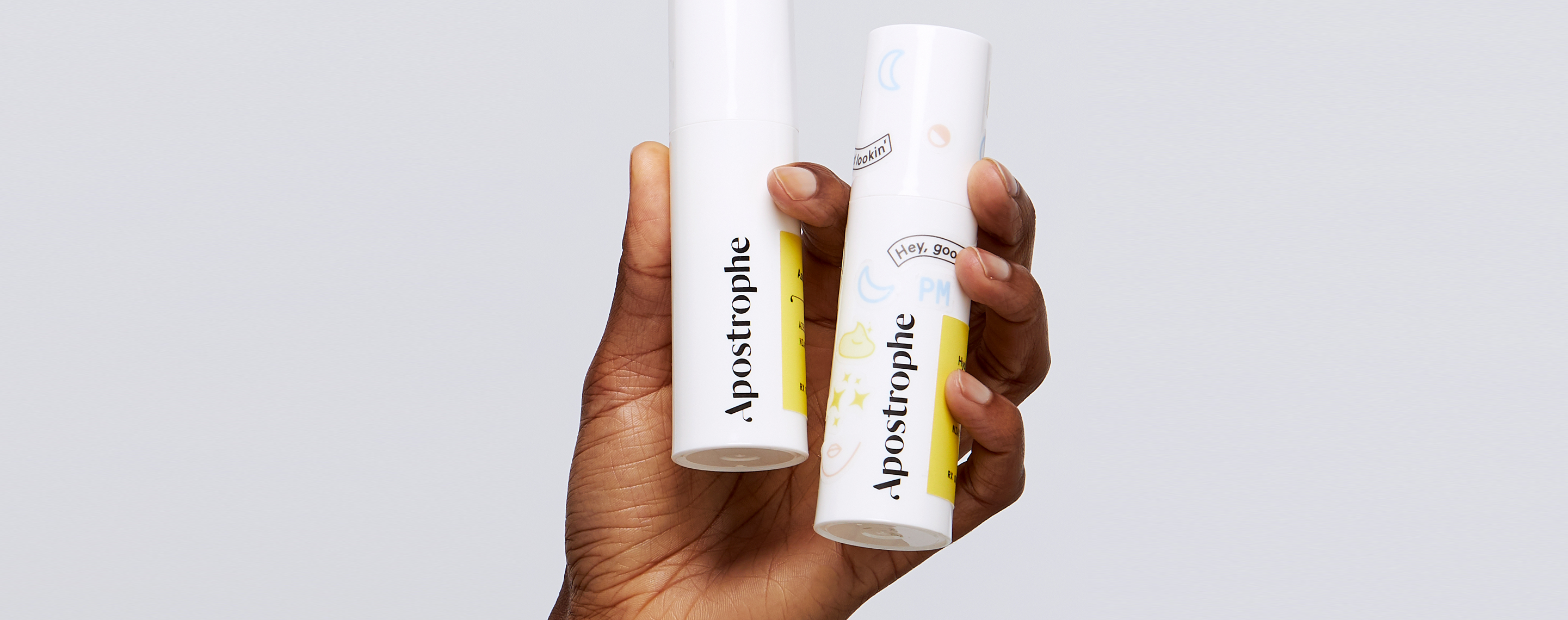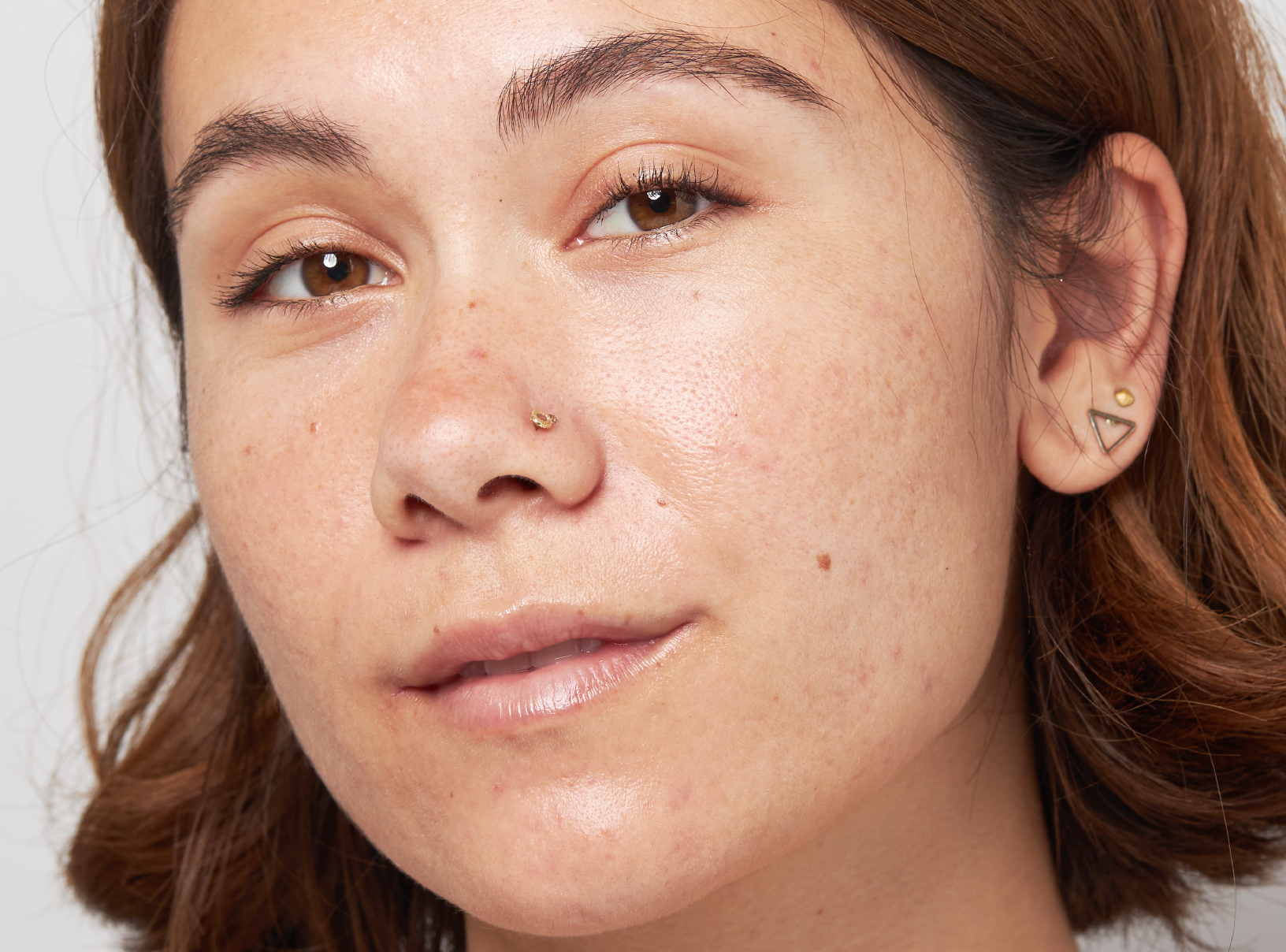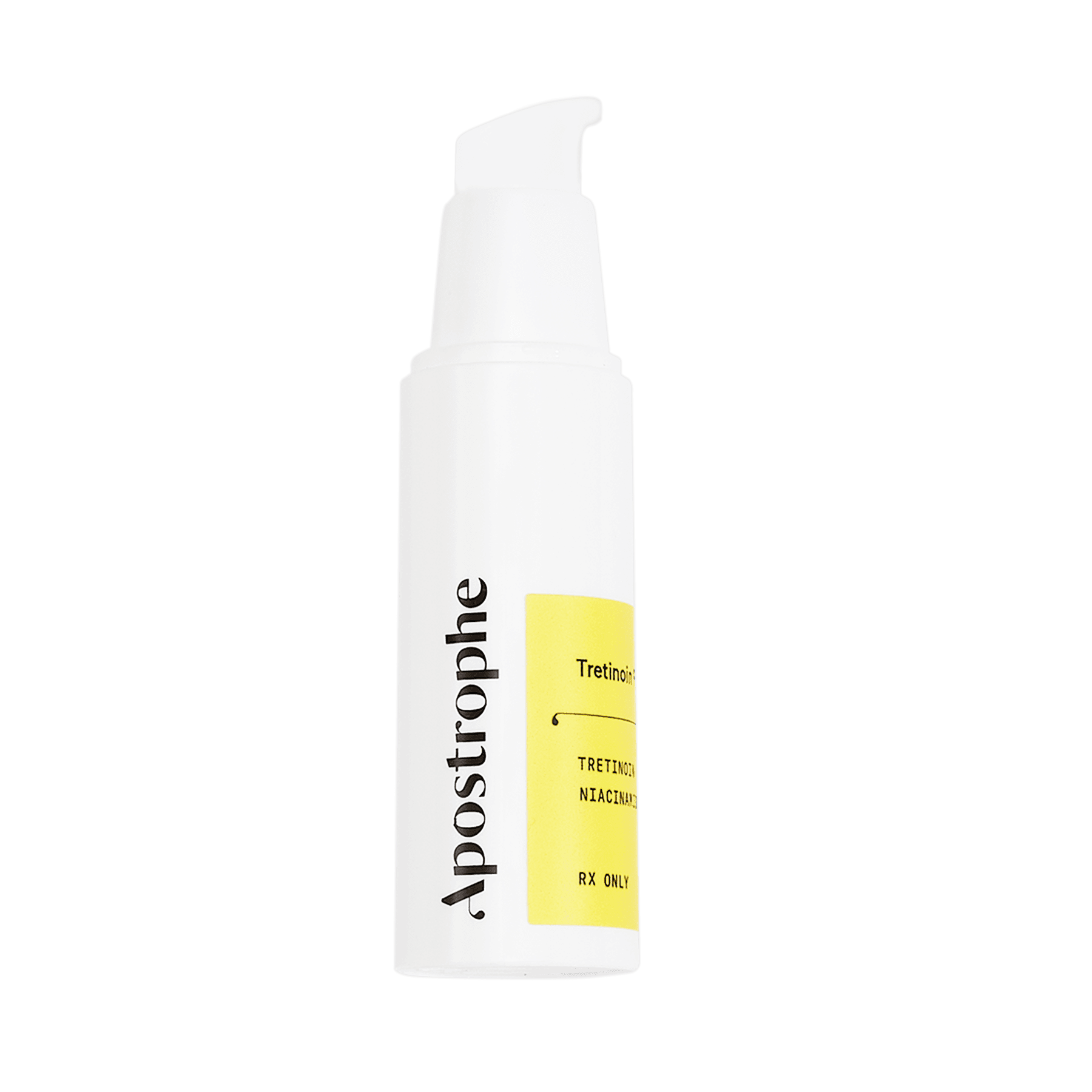Education
Azelaic Acid and Tretinoin: Can They Be Used Together?


SHARE
Education
Azelaic Acid and Tretinoin: Can They Be Used Together?
Medically reviewed by Angela Sheddan, DNP, FNP-BC
Written by Apostrophe Team
Last updated 4/5/2024
At some point in your childhood, our guess is you came across a movie called Ghostbusters.
In the film, the guys wielded powerful laser-esque weapons to trap ghosts and ghouls, but crossing the beams could lead to chaos.
Where are we going with this? There are many powerful tools to effectively treat skin issues and fight conditions like acne and aging.
The thing is, many of them shouldn’t be mixed. Crossing medications could lead to skin irritation, injury, or worse. (Read: Chaos.)
Which brings us to the topic at hand. Azelaic acid and tretinoin are two powerful weapons in the treatment of acne, and they seem like they might work well together. So can you cross these streams?
The answer, surprisingly, is a qualified yes. Azelaic acid and tretinoin make quite the dynamic duo, to borrow from another superhero staple.
To understand why, we need to look at the science behind them.
What Is Azelaic Acid?
Azelaic acid is one of several topical therapies applied to the skin to treat a variety of acne-related symptoms, but it works a bit differently from many you might already be using.
How azelaic acid works is a little complicated, so let’s take this step by step.
Azelaic acid is both an anti-inflammatory medication and an antibacterial medication. It is effective at decreasing swelling and redness associated with conditions like inflammatory acne and rosacea, which can make your skin look bumpy, uneven, and splotchy.
It’s also capable of killing the bacteria associated with mild, severe, and moderate acne in your pores.
Azelaic acid does this in part by decreasing the production of keratin — which essentially is a compound of proteins in your skin responsible for its structure and sometimes tougher texture.
Tougher skin cells can cause more pore clogging, and clogged pores full of skin cells provide a food source for acne bacteria. Reducing keratin levels can help prevent that buildup.
Tretinoin and Topical Retinoids
So how does azelaic acid work alongside tretinoin? Well, to explain that we need to first establish what tretinoin is: a prescription retinoid.
Retinoids and the retinoid forms retinol and tretinoin (Retin-A) are all a form of the vitamin-A compound frequently used in skincare products.
These medications are used for a variety of purposes, such as evening out skin tone and reducing pigmentation and dark spots.
They’re also frequently recommended for cosmetic concerns like aging and acne.
Tretinoin — the generic version of Retin-A is a stronger, prescription class retinoid, and is found in products like Apostrophe tretinoin cream.
Retin-A has a higher concentration of vitamin-A and is therefore a stronger retinoid.
While there’s debate on whether you need that extra power, a healthcare professional will ultimately make that determination for you.
What we can tell you is that the lower-strength versions can cause fewer side effects and adverse reactions.
Side effects of retinol can include dry skin and burning sensations, and you might see peeling and photosensitivity when you begin using a retinoid.
In higher concentrations (like those in tretinoin and prescription versions) the side effects can be more severe. However, starting slowly can help ease these side effects and they typically resolve once your skin adjusts to treatment.
Can Tretinoin and Azelaic Acid be Used Together?
As mentioned above, the question of whether these two medications can be used side by side gets a qualified “yes” from the medical community.
Azelaic acid and tretinoin are good to go, as long as you follow the instructions from your provider.
One study showed that tretinoin has the ability to enhance the positive effects of topical application of azelaic acid on the skin condition melasma, which is a discoloration and patchy pigmentation condition.

CUSTOMIZED HYPERPIGMENTATION TREATMENT
Get customized treatment for your dark spots, melasma, and hyperpigmentation.
The study revealed that applying tretinoin with azelaic acid lightened skin dark spots more effectively than using topical azelaic acid alone.
Another study looked at the duo’s effects on acne. It found that the combination of azelaic acid and tretinoin in a cream helped reduce inflammation and bacterial proliferation, manage sebum production, and moderate hyperkeratinization.
Possible Side Effects
It’s important to note that azelaic acid and tretinoin both can lead to side effects.
While the studies mentioned above showed no significant change in side effect risk from the combination of the medications, it’s good to be aware that each comes with its own side effect risks.
Azelaic acid can cause itching, stinging, tingling, burning, tenderness, and skin dryness when applied to the skin.
In rarer cases, swelling, rashes, hives, and difficulty breathing have been reported.
Tretinoin’s side effects can include all mentioned above, as well as the potential for exacerbating existing skin conditions you’re already suffering from and irritating sensitive skin.
And the first time you use a topical retinoid like this, you might experience the Tretinoin Purge, which can look like increased breakouts or peeling, kind of like a chemical peel.
You’ll want to mention existing conditions and sensitive skin to a healthcare professional before starting a tretinoin or Retin-A regimen.
And of course, if you experience any side effects, you should bring them to a healthcare provider’s attention, too.
Tretinoin and Azelaic Acid: Making Magic
If you’re currently using one of these products and thinking about including the other, know there’s evidence these treatments work well together.
But as much as the research might suggest this is a green-lit combination, the safe and smart thing is to talk to your healthcare provider before employing a new medication alongside existing treatments.
To be frank, your healthcare provider knows more about the potential conflicts and side effects that you might individually experience, and their knowledge of your previous skin issues can inform a recommendation that’s safe for you.
That may very well include both of these products if you suffer from inflammatory acne, but it might not if there’s a potential for you to suffer side effects.
On the other hand, a healthcare professional may give you the green light to use both azelaic acid and tretinoin for punched-up acne care with the added anti-aging benefits that come with. Apostrophe offers access to a tretinoin + azelaic acid formula that has both powerhouse ingredients in one topical treatment!
Taking the right steps to get the skin you want might require a few extra conversations, but in the long run the right choices will give you the glowy, blemish-free skin you want, and we suspect that’s the long-term goal.
15 Sources
Rathi S. K. (2011). Acne vulgaris treatment : the current scenario. Indian journal of dermatology, 56(1), 7–13. https://www.ncbi.nlm.nih.gov/pmc/articles/PMC3088940/.
Clindamycin: Medlineplus drug information. (n.d.). Retrieved May 01, 2021, from https://medlineplus.gov/druginfo/meds/a682399.html.
Telang P. S. (2013). Vitamin C in dermatology. Indian dermatology online journal, 4(2), 143–146. https://www.ncbi.nlm.nih.gov/pmc/articles/PMC3673383/#:~:text=Vitamin%20C%20is%20a%20potent,for%20the%20treatment%20of%20hyperpigmentation.
Rodan, K., Fields, K., Majewski, G., & Falla, T. (2016). Skincare Bootcamp: The Evolving Role of Skincare. Plastic and reconstructive surgery. Global open, 4(12 Suppl Anatomy and Safety in Cosmetic Medicine: Cosmetic Bootcamp), e1152. https://www.ncbi.nlm.nih.gov/pmc/articles/PMC5172479/.
Retinoids. (2020). In LiverTox: Clinical and Research Information on Drug-Induced Liver Injury. National Institute of Diabetes and Digestive and Kidney Diseases. https://pubmed.ncbi.nlm.nih.gov/31643883/.
Yoham AL, Casadesus D. Tretinoin. updated 2020 dec 5. In: StatPearls internet. Treasure Island (FL): StatPearls Publishing; 2021 Jan-. Available from: https://www.ncbi.nlm.nih.gov/books/NBK557478/.
Jegasothy, S. M., Zabolotniaia, V., & Bielfeldt, S. (2014). Efficacy of a New Topical Nano-hyaluronic Acid in Humans. The Journal of clinical and aesthetic dermatology, 7(3), 27–29. Retrieved from https://www.ncbi.nlm.nih.gov/pmc/articles/PMC3970829/.
American Academy of Dermatology Association. (n.d.). CAN THE RIGHT DIET GET RID OF ACNE? Retrieved March 5, 2021, from https://www.aad.org/public/diseases/acne/causes/diet.
Acne. (n.d.). Retrieved January 28, 2021, from https://www.hopkinsmedicine.org/health/conditions-and-diseases/acne.
Jović A, Marinović B, Kostović K, Čeović R, Basta-Juzbašić A, Bukvić Mokos Z. The Impact of Pyschological Stress on Acne. Acta Dermatovenerol Croat. 2017 Jul;25(2):1133-141. PMID: 28871928. Retrieved from: https://pubmed.ncbi.nlm.nih.gov/28871928
Palma, L., Marques, L. T., Bujan, J., & Rodrigues, L. M. (2015). Dietary water affects human skin hydration and biomechanics. Clinical, cosmetic and investigational dermatology, 8, 413–421. Retrieved from https://www.ncbi.nlm.nih.gov/pmc/articles/PMC4529263/
Pappas A. (2009). The relationship of diet and acne: A review. Dermato-endocrinology, 1(5), 262–267. Retrieved from https://www.ncbi.nlm.nih.gov/pmc/articles/PMC2836431/
Bouloc, A., Vergnanini, A. L., & Issa, M. C. (2015). A double-blind randomized study comparing the association of Retinol and LR2412 with tretinoin 0.025% in photoaged skin. Journal of cosmetic dermatology, 14(1), 40–46. https://pubmed.ncbi.nlm.nih.gov/25603890/.
Mukherjee, S., Date, A., Patravale, V., Korting, H. C., Roeder, A., & Weindl, G. (2006). Retinoids in the treatment of skin aging: an overview of clinical efficacy and safety. Clinical interventions in aging, 1(4), 327–348.https://www.ncbi.nlm.nih.gov/pmc/articles/PMC2699641/.
Retinoid or retinol? American Academy of Dermatology. (n.d.). https://www.aad.org/public/everyday-care/skin-care-secrets/anti-aging/retinoid-retinol.
Shop this post

Tretinoin

Finacea (azelaic acid)
Like what you just read? Sign up for our email list to get the scoop on skincare science delivered straight to your inbox.

Deep Dives
A dermatologist shares his thoughts on the recent studies about benzoyl peroxide and benzene.
Read More
Education
What is milia?
What is milia? Today, we’re jumping into one type of bump that you may have heard about most commonly in infants — milia.
Read More
Education
Best moisturizer for acne-prone skin
If you have combination acne-prone skin, figuring out which moisturizer is best for your skin might be tough. In this guide, we break down the best moisturizer for combination, acne-prone skin.
Read More